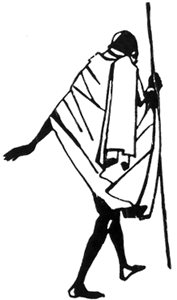
P.O. SEVAGRAM, DIST.WARDHA 442102, MS, INDIA. Phone: 91-7152-284753
FOUNDED BY MAHATMA GANDHI IN 1936
GANDHI PHILOSOPHY : Gandhian view on Non-Violence
Read articles about Gandhian view On Non-Violence

GANDHI PHILOSOPHY
On Non-Violence
Gandhi's View
- Non-violence & World Crisis
- Nonviolence Vs. Violence
- Religion Vs. No Religion
- The Doctrine of The Sword
- My Faith in Nonviolence
From The Mind of Mahatma Gandhi
- Resistance To Aggression
- The Choice before India
- The Way to Peace
- The Gospel of Nonviolence
- The Power of Nonviolence
- Training For Nonviolence
- Application of Nonviolence
- The Nonviolent Society
- The Nonviolent State
- Violence & Terrorism
- Between Cowardice and Violence
- India And The Nonviolent Way
- India And The Violent Way
- Nuclear War: The Atom Bomb
From A Pictorial Biography of Mahatma Gandhi
Martin Luther King's views
- The Meaning of Nonviolence
- Pilgrimage To Nonviolence
- Kingian Nonviolence : A Practical Application in Policing
Gandhi's Struggle for Nonviolence
- The Birth of Satyagraha
- Domestic Satyagraha
- Satyagraha At Viramgam
- The Indian Emigration Act
- The Champaran Struggle
- The Mill-Hands of Ahmedabad
- The Kheda Struggle
- Satyagraha in South Africa
Articles
- Violence and Its Dimensions
- Youth, Nonviolence And Gandhi
- Peace Paradigms : Five Approaches to Peace
- Nonviolent Action: Some Dilemmas
- Conflict, Violence And Education
- Peace Education for the Millennium
- Martin Luther King's Nonviolent Struggle and its Relevance to Asia
Books Online
- My Non-violence : M. K. Gandhi
- Conflict Resolution and Gandhian Ethics : Thomas Weber
- Nonviolence After Gandhi (PDF Version) : Edited by G. Ramachandran & T. K. Mahadevan
- Gandhi-His Relevance for Our Times : Edited by G. Ramachandran & T. K. Mahadevan
- Gandhi And South Africa(PDF Version) : E. S. Reddy
- Sabarmati To Dandi : Jyotsna Tiwari
Conflict Resolution
- Role of Academics in Conflict Resolution
- Conflict, Violence And Education
- Moral Equivalent of War As A Conflict Resolution
- The Emerging Role of NGOs in Conflict Resolution
- Gandhi's Role and Relevance in Conflict Resolution
- Interpersonal Conflict
- The Role of Civil Society in Conflict Resolution
- An Approach to Conflict Resolution
Gandhiji's Struggle for Non-Violence : The Birth of Satyagraha
Events were so shaping themselves in Johannesburg as to make this self-purification on my part a preliminary as it were to Satyagraha. I can now see that all the principal events of my life, culminating in the vow of Brahmacharya, were secretly preparing me for it. The principle called Satyagraha came into being before that name was invented. Indeed when it was born, I myself could not say what it was. In Gujarati also we used the English phrase 'passive resistance' to describe it. When in a meeting of Europeans I found that the term 'passive resistance' was too narrowly construed, that it was supposed to be a weapon of the weak, that it could be characterized by hatred, and that it could finally manifest itself as violence, I had to demur to all these statements and explain the real nature of the Indian movement. It was clear that a new word must be coined by the Indians to designate their struggle.
But I could not for the life of me find out a new name, and therefore offered a nominal prize through Indian Opinion to the reader who made the best suggestion on the subject. As a result Maganlal Gandhi coined the word 'Sadagraha' (Sat=truth, Agraha=firmness) and won the prize. But in order to make it clearer I changed the word to 'Satyagraha' which has since become current in Gujarati as a designation for the struggle.
The history of this struggle is for all practical purposes a history of the remainder of my life in South Africa and especially of my experiments with truth in that sub-continent. I wrote the major portion of this history in Yeravda jail and finished it after I was released. It was published in Navajivan and subsequently issued in book form. Sjt. Valji Govindji Desai has been translating it into English for Current Thought, but I am now arranging to have the English translation published in book form at an early date, so that those who will may be able to familiarize themselves with my most important experiments in South Africa. I would recommend a perusal of my history of Satyagraha in South Africa to such readers as have not seen it already. I will not repeat what I have put down there, but in the next few chapters will deal only with a few personal incidents of my life in South Africa which have not been covered by that history. And when I have done with these, I will at once proceed to give the reader some idea of my experiments in India. Therefore, anyone who wishes to consider these experiments in their strict chronological order will now do well to keep the history of Satyagraha in South Africa before him.
Source : "The Selected Works of Mahatma Gandhi Autobiography (Vol. 1)